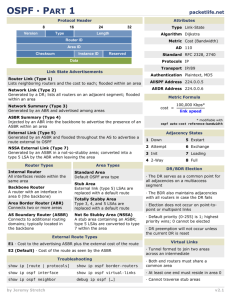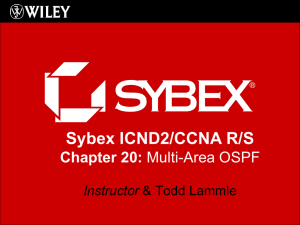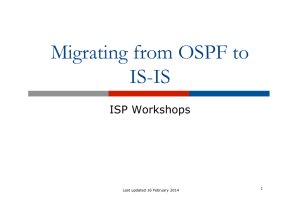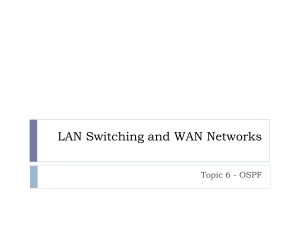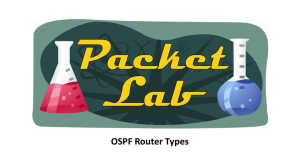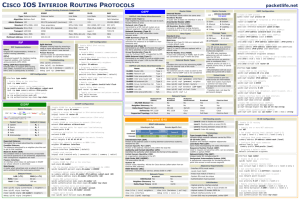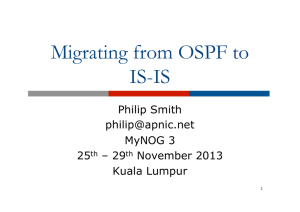ISIS vs OSPF - Workshops
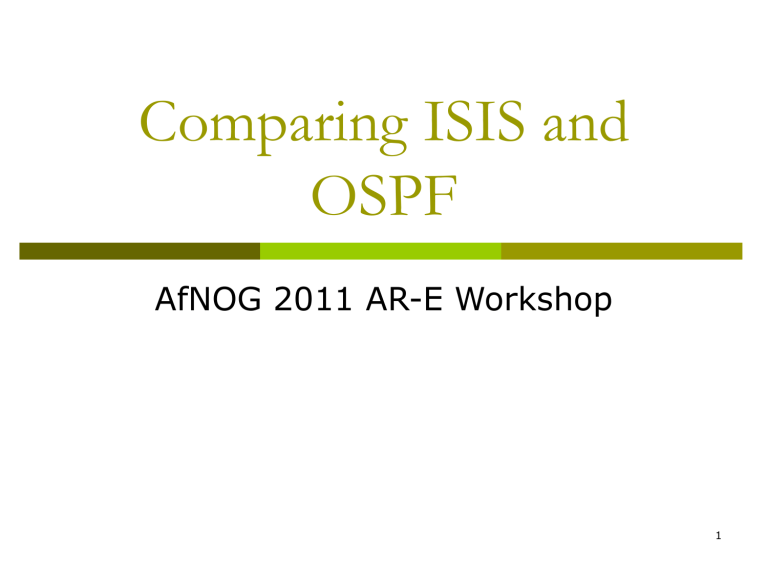
Comparing ISIS and
OSPF
AfNOG 2011 AR-E Workshop
1
Comparing ISIS and OSPF
Both are Link State Routing Protocols using the Dijkstra SPF Algorithm
So what’s the difference then?
And why do ISP engineers end up arguing so much about which is superior?
2
What Is IS-IS ?
Intermediate System to Intermediate
System
An “IS” is ISO terminology for a router
IS-IS was originally designed for use as a dynamic routing protocol for ISO CLNP, defined in the ISO 10589 standard
Later adapted to carry IP prefixes in addition to CLNP (known as Integrated or Dual IS-IS) as described in RFC 1195
Predominantly used in ISP environment
3
IS-IS Timeline
1978ish “New” Arpanet Algorithm
Eric Rosen et al
1986 to 90 Decnet Phase V
Radia Perlman, Mike Shand
1987 ISO 10589 (IS-IS)
Dave Oran
1990 RFC 1195 (Integrated IS-IS)
Ross Callon, Chris Gunner
1990 to present: All sorts of enhancements
Everyone contributed!
2008 RFC5308 adds IPv6 support
And RFC5120 adds Multi-Topology Routing support
4
What Is OSPF ?
Open Shortest Path First
Link State Protocol using the Shortest Path First algorithm (Dijkstra) to calculate loop-free routes
Used purely within the TCP/IP environment
Designed to respond quickly to topology changes but using minimal protocol traffic
Used in both Enterprise and ISP Environment
5
OSPF Timeline
Development began in 1987 by IETF
OSPFv1 published in 1989 with RFC 1131
OSPFv2 published in 1991 with RFC 1247
Further enhancements to OSPFv2 in 1994 with
RFC 1583 and in 1997 with RFC 2178
Last revision was in 1998 with RFC 2328 to fix minor problems
All above OSPF RFCs authored by John Moy
RFC2740 introduced OSPFv3 (for IPv6) in 1999, replaced by RFC5340 in 2008
6
IS-IS & OSPF:
Similarities
Both are Interior Gateway Protocols (IGP)
They distribute routing information between routers belonging to a single Autonomous System (AS)
With support for:
Classless Inter-Domain Routing (CIDR)
Variable Subnet Length Masking (VLSM)
Authentication
Multi-path
IP unnumbered links
7
IS-IS and OSPF Terminology
OSPF
Host
Router
Link
Packet
Designated router (DR)
Backup DR (BDR)
Link-State Advertisement
(LSA)
Hello packet
Database Description
(DBD)
ISIS
End System (ES)
Intermediate System (IS)
Circuit
Protocol Data Unit (PDU)
Designated IS (DIS)
N/A (no BDIS is used)
Link-State PDU (LSP)
IIH PDU
Complete sequence number
PDU (CSNP)
8
IS-IS and OSPF Terminology
(Cont.)
OSPF
Area
Non-backbone area
Backbone area
Area Border Router
(ABR)
Autonomous System
Boundary Router
(ASBR)
ISIS
Sub domain (area)
Level-1 area
Level-2 Sub domain
(backbone)
L1L2 router
Any IS
9
Transport
OSPF uses IP Protocol 89 as transport
Data Link Header IP Header OSPF Header OSPF Data
IS-IS is directly encapsulated in Layer 2
Data Link Header IS-IS Header IS-IS Data
10
For Service Providers
Which IGP should an ISP choose?
Both OSPF and ISIS use Dijkstra SPF algorithm
Exhibit same convergence properties
ISIS less widely implemented on router platforms
ISIS runs on data link layer, OSPF runs on IP layer
11
For Service Providers
Biggest ISPs tend to use ISIS – why?
In early 90s, Cisco implementation of ISIS was much more solid than OSPF implementation –
ISPs naturally preferred ISIS
Main ISIS implementations more tuneable than equivalent OSPF implementations – because biggest ISPs using ISIS put more pressure on
Cisco to implement “knobs”
12
For Service Providers
Moving forward a decade
Early Cisco OSPF implementation substantially rewritten
Now competitive with ISIS in features and performance
Router vendors wishing a slice of the core market need an ISIS implementation as solid and as flexible as that from Cisco
Those with ISIS & OSPF support tend to ensure they exhibit performance and feature parity
13
How to choose an IGP?
OSPF
Rigid area design – all networks must have area 0 core, with sub-areas distributed around
Suits ISPs with central high speed core network linking regional PoPs
Teaches good routing protocol design practices
14
How to choose an IGP?
ISIS
Relaxed two level design – L2 routers must be linked through the backbone
Suits ISPs with “stringy” networks, diverse infrastructure, etc, not fitting central core model of OSPF
More flexible than OSPF, but easier to make mistakes too
15
Other considerations
ISIS runs on link layer
Not possible to “attack” the IGP using IP as with OSPF
ISIS’s NSAP addressing scheme avoids dependencies on IP as with OSPF
Because biggest ISPs use ISIS, major router vendors tend to apply new optimisation features before they are added to OSPF
16
Comparing ISIS and
OSPF
AfNOG 2011 AR-E Workshop
17



